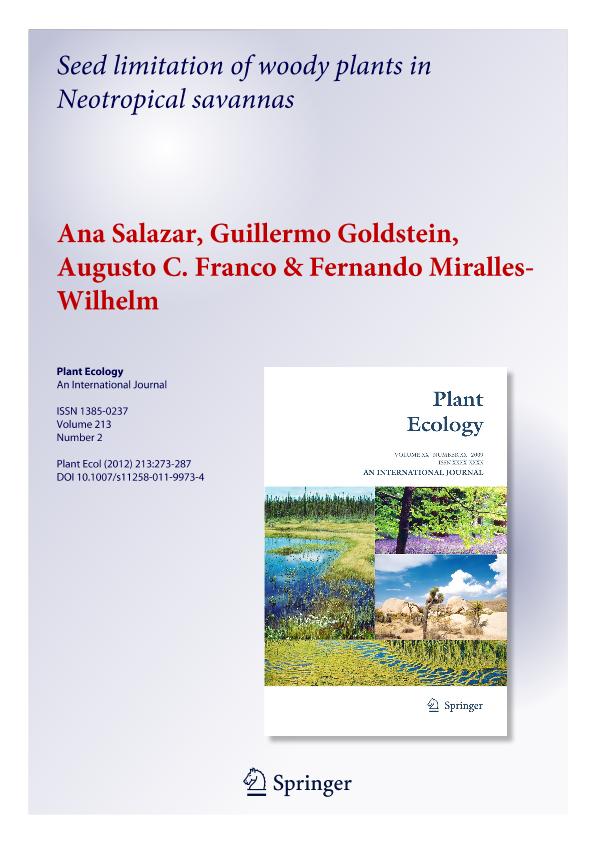Mostrar el registro sencillo del ítem
dc.contributor.author
Salazar, Ana
dc.contributor.author
Goldstein, Guillermo Hernan

dc.contributor.author
Franco, Augusto C.
dc.contributor.author
Miralles Wilhelm, Fernando
dc.date.available
2019-01-18T18:36:49Z
dc.date.issued
2012-02
dc.identifier.citation
Salazar, Ana; Goldstein, Guillermo Hernan; Franco, Augusto C.; Miralles Wilhelm, Fernando; Seed limitation of woody plants in Neotropical savannas; Springer; Plant Ecology; 213; 2; 2-2012; 273-287
dc.identifier.issn
1385-0237
dc.identifier.uri
http://hdl.handle.net/11336/68261
dc.description.abstract
The failure of seeds to arrive at all suitable sites (seed limitation) greatly affects plant distribution and abundance. In contrast to tropical forests, the degree of seed limitation in Neotropical savannas is unclear because empirical studies at the community level are scarce. We estimated seed limitation of 23 woody species from annual seed rain measurements along a tree density gradient in the savannas of Central Brazil. These savannas differ in tree density and canopy cover, from closed to open savannas, and are located along shallow topographic gradients. We also studied post-dispersal seed predation and removal of 17 representative woody species, and seed viability loss over time of 12 common woody species under dry-storage conditions. Annual seed rain was lower in open (410 seeds/m 2) than in closed savannas (773 seeds/m 2). Average seed limitation across woody species was higher than 80% along the tree density gradient. More than 60% of seeds of the studied woody species were predated or removed within 30-45 days in all savannah types. Seeds of most common woody species (66%) lost their viability in less than 12 months of dry storage. This study shows that Neotropical savannah woody plants are strongly seed-limited because of low and poor distribution of seeds among sites, post-dispersal seed removal, and short seed longevity. The high seed limitation of tree species in Neotropical savannas, particularly in open savannas, also may contribute to maintain their relatively low tree densities and help to explain the spatial variation of tree abundance along topographic gradients.
dc.format
application/pdf
dc.language.iso
eng
dc.publisher
Springer

dc.rights
info:eu-repo/semantics/openAccess
dc.rights.uri
https://creativecommons.org/licenses/by-nc-sa/2.5/ar/
dc.subject
Cerrado
dc.subject
Seed Dispersal
dc.subject
Seed Removal
dc.subject
Seed Viability
dc.subject.classification
Otras Ciencias Biológicas

dc.subject.classification
Ciencias Biológicas

dc.subject.classification
CIENCIAS NATURALES Y EXACTAS

dc.title
Seed limitation of woody plants in Neotropical savannas
dc.type
info:eu-repo/semantics/article
dc.type
info:ar-repo/semantics/artículo
dc.type
info:eu-repo/semantics/publishedVersion
dc.date.updated
2019-01-17T13:54:53Z
dc.identifier.eissn
1573-5052
dc.journal.volume
213
dc.journal.number
2
dc.journal.pagination
273-287
dc.journal.pais
Alemania

dc.description.fil
Fil: Salazar, Ana. University of Miami; Estados Unidos
dc.description.fil
Fil: Goldstein, Guillermo Hernan. University of Miami; Estados Unidos. Universidad de Buenos Aires. Facultad de Ciencias Exactas y Naturales. Departamento de Ecología, Genética y Evolución; Argentina. Consejo Nacional de Investigaciones Científicas y Técnicas; Argentina
dc.description.fil
Fil: Franco, Augusto C.. Universidade do Brasília; Brasil
dc.description.fil
Fil: Miralles Wilhelm, Fernando. Florida International University; Estados Unidos
dc.journal.title
Plant Ecology

dc.relation.alternativeid
info:eu-repo/semantics/altIdentifier/doi/http://dx.doi.org/10.1007/s11258-011-9973-4
dc.relation.alternativeid
info:eu-repo/semantics/altIdentifier/url/https://link.springer.com/article/10.1007%2Fs11258-011-9973-4
Archivos asociados
